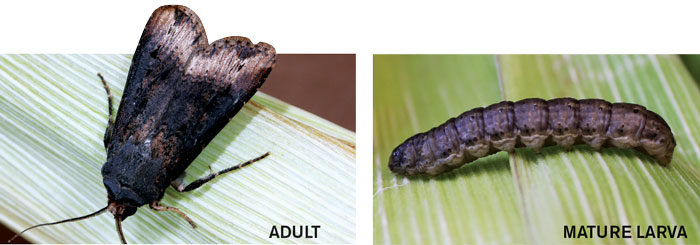No-Till Farmer
Get full access NOW to the most comprehensive, powerful and easy-to-use online resource for no-tillage practices. Just one good idea will pay for your subscription hundreds of times over.

ADULT ID. Adult black cutworm moths are about 1.5 inches long with dark brown to black forewings highlighted by a lighter band at the bottom of the wing.
MATURE LARVA. A fourth-instar black cutworm larva will be roughly 2 inches long and can cut 3-5 corn plant seedlings during its feeding life.
Courtesy Iowa State University Extension Outreach
At certain times in their development, black cutworm larvae can each cut 3-5 corn plants during the early season, which can lead to significant yield losses in fields where the pest reproduces in large numbers.
No-tillers should be on guard for outbreaks of the migratory pest, which blows into the Corn Belt and Great Plains on southwesterly winds and storm fronts in the early spring, beginning as early as the end of February in some areas. The no-till connection with the black cutworm can be traced to the pest’s ability to survive and reproduce on field residue and cover crops during the early spring — in time to attack seedling corn as summer approaches.
Entomologists at Iowa State University, the University of Illinois and Purdue University say scouting for black cutworm larvae is one of the most important steps growers can take to prevent outbreaks and hot spots in their young corn because populations of the pest can vary from year to year.
Illinois Crop Sciences literature explains factors that favor black cutworm outbreaks are late planting, reduced tillage, infestations of weeds before planting, fields next to permanent vegetation and excess crop residue, as would be found in many no-till fields. Outbreaks also are more likely to occur in corn planted after soybeans than in corn-on-corn fields.
Purdue entomologists say black cutworm moths overwinter in Texas and Mexico, and they are attracted to early-spring vegetation in their new homes far north of the Rio Grande. There they mate and deposit…